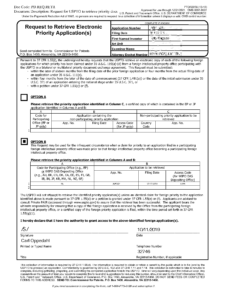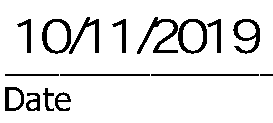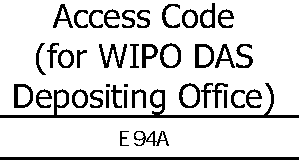
(Update: A letter got sent on February 22, 2020 to the Commissioner for Patents at the USPTO, asking the USPTO to reformat this form. See blog post.)
Which patent form on the USPTO web site is the most poorly designed? Just now the form at the top of my list of poorly designed forms is Form PTO/SB/38, the Request to Retrieve Priority Applications.
It is recalled from 37 CFR § 1.55(f)(1) that in a utility patent case, you are in Big Trouble if you fail to somehow deliver a certified copy of the priority document to the USPTO within the crucial 4-and-16 time period:
A certified copy of the foreign application must be filed within the later of four months from the actual filing date of the application, or sixteen months from the filing date of the prior foreign application … except as provided in paragraphs (h), (i), and (j) of this section.
Clearly one way to satisfy this requirement is to physically deliver to the USPTO a physical certified copy of the foreign application within this crucial 4-and-16 time period. But the whole point of the DAS system (and the PDX system that preceded it) is that you should be able to use the DAS system instead of having to physically deliver a physical certified copy.
Which of course prompts the reader to try to work out what is in “paragraphs (h), (i), and (j)” that somehow gives the filer a free pass on having to to physically deliver a physical certified copy. (And yes, I know about the “interim copy” procedure which is a lot of extra work for the filer and which should not be needed at all if USPTO would only handle DAS requests in a customer-friendly way.)
And the answer is, if you want to get a free pass on having to to physically deliver a physical certified copy, you have to do the following:
- you have to present the priority claim itself timely and accurately before the expiration of the 4-and-16 time period; and
- you have to provide “the information necessary for the participating foreign intellectual property office to provide the Office with access to the foreign application” before the expiration of the 4-and-16 time period; and
- you have to get lucky in that the USPTO must somehow successfully retrieve the electronic certified copy of the foreign application before the patent issues.
Let’s briefly review these three requirements. Keep in mind that if you somehow fall short on any of these three requirements, then to salvage the priority claim you must file a $400 petition. Or you need to have been in possession of a crystal ball that works well enough that you were able to predict that one or another of these three requirements would fail, and prompted by your crystal ball you took the extra steps and file clutter of filing an “interim copy” as mentioned above.
First requirement: presenting the priority claim timely and accurately. You do this in an ADS. It’s easy to do and everything about it is within your control. Indeed if you do it right, your ADS will have auto-loaded into Palm and you will be able to confirm everything in Palm within minutes of your first EFS-Web submission.
Third requirement: getting lucky. This is not easy to satisfy, because it requires someone at USPTO to be competent in carrying out the two mouse clicks that are needed to retrieve the electronic certified copy from DAS. It also requires someone at USPTO to actually realize that they need to carry out the two mouse clicks. It also requires that the foreign patent office did actually make the application available to DAS. It requires that the foreign patent office did accurately communicate the DAS access code to foreign counsel, and it requires that foreign counsel did accurately communicate the DAS access code to you. You do have at least some limited ability to identify potential problem areas about this, because presumably you will have loaded the priority application into your DAS workbench, and you will have obtained a Certificate of Availability for this application, attesting to the application actually being available to DAS. You will also have set up an “alert” so that the moment USPTO does retrieve the electronic certified copy, the DAS system will notify you that the USPTO did retrieve the electronic certified copy.
Unfortunately, given the wording of Rule 55, the burden is on you, the filer, to be the watchdog to make sure that USPTO does actually carry out the two mouse clicks. In the event that the USPTO assigns someone to the mouse clicking who lacks the competence to do the mouse clicking correctly, the burden is on you, the filer, to pester the USPTO to keep trying, perhaps assigning a different person to the task if needed.
The filer who snoozes too long about this can end up with a failed priority claim, for no better reason than that the filer only reminded the USPTO say, six times to do the two mouse clicks when seven times would actually have been required to bring about the result.
Providing “the information necessary”. What exactly is “the information necessary”? The answer is:
- the two-letter ISO-3166 code for the Office where the foreign application was filed;
- the application number of the foreign application;
- the filing date of the foreign application; and
- the DAS access code (a four-character secret code).
There are two ways to provide “the information necessary”, namely:
- the Application Data Sheet; or
- Form PTO/SB/38.
So the big fear for any filer is that the USPTO might wait until after the 4-and-16 time period has passed, and might then spring it upon the filer that there is some real or imagined defect in “the information necessary”. This is no idle fear. There are many real-life instances of the USPTO waiting until after the 4-and-16 time period to try for the first time to do the two mouse clicks. If at that point the USPTO deems the ADS to be supposedly not clearly readable (this has happened) or deems the Form PTO/SB/38 to be supposedly not clearly readable (this has also happened), then the filer is stuck filing the $400 petition to get the USPTO to try the two mouse clicks again, this time using some supposedly more legible document.
Other ways for this trap to swing shut include:
- the bad luck that the Office where the foreign application was filed did not actually make the application available to DAS even though they said they did; or
- the bad luck that the Office where the foreign application was filed did make it available to DAS but did it incorrectly (with incorrect meta-data for example); or
- the bad luck that the DAS access code somehow did not get communicated accurately from the foreign patent office to foreign counsel; or
- the bad luck that the DAS access code somehow did not get communicated accurately from foreign counsel to US counsel; or
- the bad luck that a filing date was inaccurately communicated from foreign counsel to US counsel (imagine 4-5 meaning April 5 or May 4); or
- the bad luck that the foreign application number was inaccurately communicated from foreign counsel to US counsel; or
- the bad luck that the filing date was inaccurately transcribed into the ADS or the Form PTO/SB/38; or
- the bad luck that the DAS access code was inaccurately transcribed into the ADS or the Form PTO/SB/38; or
- the bad luck that the wrong ISO-3166 Office code got transcribed into the ADS or the Form PTO/SB/38; or
- the bad luck that the foreign application number was inaccurately transcribed into the ADS or the Form PTO/SB/38.
Risk factors 1-6 can be eliminated by the step of loading the foreign application into one’s DAS workbench, and obtaining a Certificate of Availability. Risk factors 7-10 can be nearly eliminated by copying and pasting from the filer’s DAS workbench into the ADS or the Form PTO/SB/38.
Which now brings us to why I have nominated Form PTO/SB/38 as perhaps the most poorly designed patent form on the USPTO web site. If you look at the form, you can see that it is a “fillable” PDF form, meaning that you click in a box and start typing, and the form determines the font size. You do not get to pick the font size.
 Look toward the bottom of the form, paying attention to the boxes for the date and the filer’s telephone number. Those boxes determine the font size to be twenty-six-point font. Neither the date nor the telephone number are likely to be crucial to the process, but if somehow they turned out to be important, at 26 points they would be readable (even with half-toning as discussed below).
Look toward the bottom of the form, paying attention to the boxes for the date and the filer’s telephone number. Those boxes determine the font size to be twenty-six-point font. Neither the date nor the telephone number are likely to be crucial to the process, but if somehow they turned out to be important, at 26 points they would be readable (even with half-toning as discussed below).
 Now look at the crucial fields, the fields which will give the USPTO an excuse to say that the filer failed to provide “the information necessary”. Here is the field for the single most crucial piece of information, namely the secret DAS Access Code. You will see that the USPTO PDF form forces the font for this box to be limited to one sixteenth of an inch high. Instead of an easy-to-read 26 points, the USPTO form limits this font to nine points or smaller.
Now look at the crucial fields, the fields which will give the USPTO an excuse to say that the filer failed to provide “the information necessary”. Here is the field for the single most crucial piece of information, namely the secret DAS Access Code. You will see that the USPTO PDF form forces the font for this box to be limited to one sixteenth of an inch high. Instead of an easy-to-read 26 points, the USPTO form limits this font to nine points or smaller.
 This would not be so bad, except that EFS-Web carries out half-toning on every document that it loads into IFW that contains at least one pixel that somehow fails to be pure black or pure white. Here is the actual result of actual USPTO half-toning in the very case that is the example for this blog article.
This would not be so bad, except that EFS-Web carries out half-toning on every document that it loads into IFW that contains at least one pixel that somehow fails to be pure black or pure white. Here is the actual result of actual USPTO half-toning in the very case that is the example for this blog article.
It is eminently predictable that USPTO would take the position that the “E94A” in this box is not legible, and thus that the filer failed to provide “the information necessary” prior to the end of the 4-and-16 time period. It is likewise eminently predictable that USPTO would fail to retrieve the electronic certified copy from the DAS system, and that USPTO would attempt to blame the filer (rather than USPTO’s own half-toning) for this failure.
The most customer-friendly thing that USPTO could do here is to attempt the two mouse clicks prior to the end of the 4-and-16 time period. Were USPTO to do this consistently, and were USPTO to report to the filer any real or imagined lapse by the filer prior to the end of the 4-and-16 time period, then this would give the filer an opportunity to get things straightened out before the end of the 4-and-16 time period. Unfortunately it is USPTO’s policy (see blog article from May of 2014) to foot-drag until well after the end of the 4-and-16 time period before carrying out the two mouse clicks:
In general, an attempt to retrieve an eligible foreign application to which priority is claimed in a U.S. application will be made by the USPTO when the application is docketed to an examiner.
(MPEP § 2015.01, emphasis added.) Docketing of an application to an examiner happens long after the application is assigned to an Art Unit. (The USPTO first dockets the application to the SPE, and then only when the case is near the top of the Art Unit’s examination queue does the SPE docket the application to the actual examiner.)
Given USPTO’s institutionalized foot-dragging as to when it will carry out the two mouse clicks, then it is incumbent upon the USPTO to at least redesign Form PTO/SB/38 so that the important boxes, namely the boxes that communicate “the information necessary” under Rule 55, permit 29-point type just like the not-particularly-important boxes such as the date or the telephone number box.
Suppose that USPTO were to have set a goal of collecting as many $400 petition fees as possible in connection with failed DAS retrievals. If USPTO had set such a goal, what would USPTO have done to further that goal? A clear first step would be to make the boxes for “the information necessary” so small that the font is only one-sixteenth of an inch tall. A clear second step would be to carry out aggressive half-toning on the Form PTO/SB/38 as part of the EFS-Web process before loading the image into IFW.
To repeat:
USPTO needs to redesign Form PTO/SB/38 so that the important boxes, namely the boxes that communicate “the information necessary” under Rule 55, permit 29-point type.
Do you agree that this form is poorly designed? If so, please post a comment below. Do you feel that some other USPTO patent form is more poorly designed than this one? If so, please post a comment below.

Good morning!
I would love if you could do a similar detailed analysis of the SB08 IDS form.
I have been a patent paralegal for 19 years and that form is by far the one that frustrates me the most.
The certification boxes do not make sense to me.
Have to agree with Sonia on the IDS form (SB08) and would also add the Application Data Sheet (ADS).
I am going to agree with Sonia and Curtis. The IDS form is frustrating for many reasons. However – the ADS is just so poorly laid out visually. The most teeth gnashing is priority field. If you have a long and complicated family to input, it’s a nightmare. Filing a divisional off one of these? You can’t just add in the new info at the top – you have to re-enter everything! What fun. And of course, there’s the ever-present extra Privacy Act page. The ADS sheet is the worst!
Pre-AIA USPTO forms were all nicely laid out with the uniform font sizing. Many of the post-AIA form were created/updated and were (and are still are) a mess with a mixture of jumbo and micro fonts scattered throughout. With Adobe Acrobat almost all of the PTO forms (PTO/SB/38 included) can quickly and easily be edited to change the font sizing and I routinely do this with each new form version when it is released and then work from my own library of forms. I understand that the PTO was in a rush to get all these new forms out post-AIA but I have never understood why they did not go back and clean them up. It would take someone competent only one day to fix.
See USPTO’s policy which says:
Changing the font size of data being filled in on the form is not a change to any text on the form. After all, it is perfectly acceptable to type or hand write that same data in a larger size, scan, and then file so why not simply change the font size to something legible for the data we add and immediately eliminate issues with our data not being visible after upload.
Anytime we actually change any text on the form (very rare), we also modify the form header to say “MODIFIED”. No issues for over a decade.
Thank you, Carl. Completely agree. Though I have another question – the explanatory text in the form indicates that Option B is used for a very “infrequent circumstance” (priority claim was originally made prior to the office becoming a depositing office in DAS).
I would imagine you use PTO/SB/38 in the far more common circumstance of obtaining the Access Code post-filing. Is the Option B explanation just misleading, or am I missing something?
Thank you for posting. No you are not missing anything. The explanation on the form is just misleading.